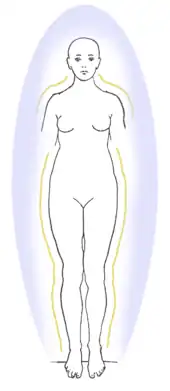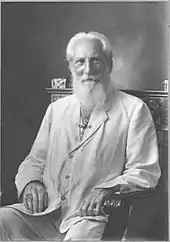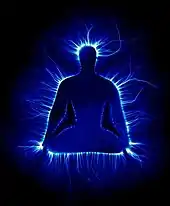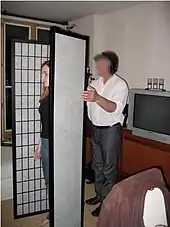Aura (paranormal)
According to spiritual beliefs, an aura or energy field is a colored emanation said to enclose a human body or any animal or object.[1] In some esoteric positions, the aura is described as a subtle body.[2] Psychics and holistic medicine practitioners often claim to have the ability to see the size, color and type of vibration of an aura.[3]

| Part of a series on the |
| Paranormal |
|---|
In spiritual alternative medicine, the human being aura is seen as part of a hidden anatomy that reflects the state of being and health of a client, often understood to even comprise centers of vital force called chakras.[1] Such claims are not supported by scientific evidence and are thus pseudoscience.[4] When tested under scientific controlled experiments, the ability to see auras has not been proven to exist.[5]
Etymology
In Latin and Ancient Greek, aura means wind, breeze or breath. It was used in Middle English to mean "gentle breeze". By the end of the 19th century, the word was used in some spiritualist circles to describe a speculated subtle emanation around the body.[6][7]
History

The concept of auras was first popularized by Charles Webster Leadbeater, a former priest of the Church of England and a member of the mystic Theosophical Society.[8] Leadbeater had studied theosophy in India, and believed he had the capacity to use his clairvoyant powers to make scientific investigations.[9] He claimed that he had discovered that most men came from Mars but the more advanced men came from the Moon, and that hydrogen atoms were made of six bodies contained in an egg-like form.[10] In his book Man Visible and Invisible published in 1903, Leadbeater illustrated the aura of man at various stages of his moral evolution, from the "savage" to the saint.[11][12] In 1910, Leadbeater introduced the modern conception of auras by incorporating the Tantric notion of chakras in his book The Inner Life.[13] Leadbeater did not simply present the Tantric beliefs to the West, he reconstructed and reinterpreted them by mixing them with his own ideas, without acknowledging the sources of these innovations. Some of Leadbeater's innovations are describing chakras as energy vortices, and associating each of them with a gland, an organ and other body parts.[14]
In the following years, Leadbeater's ideas on the aura and chakras were adopted and reinterpreted by other theosophists such as Rudolf Steiner[15] and Edgar Cayce, but his occult anatomy remained of minor interest within the esoteric counterculture until the 1980s, when it was picked up by the New Age movement.[16]
In 1977, American esotericist Christopher Hills published the book Nuclear Evolution: The Rainbow Body, which presented a modified version of Leadbeater's occult anatomy.[17] Whereas Leadbeater had drawn each chakras with intricately detailed shapes and multiple colors, Hills presented them as a sequence of centers, each one being associated with a color of the rainbow. Most of the subsequent New Age writers based their representations of the aura on Hill's interpretation of Leadbeater's ideas.[18] Chakras became a part of mainstream esoteric speculations in the 1980s and 1990s. Many New Age techniques that aim to clear blockages of the chakras were developed during those years, such as crystal healing and aura-soma.[19] Chakras were, by the late 1990s, less connected with their theosophical and Hinduist roots, and more infused with New Age ideas. A variety of New Age books proposed different links between each chakras and colors, personality traits, illnesses, Christian sacraments,[20] etc.[21] Various type of holistic healing within the New Age movement claim to use aura reading techniques, such as bioenergetic analysis, spiritual energy and energy medicine.[22]
Auric energy
In yoga participants attempt to focus on, or enhance their "auric energy shield".[23] The concept of auric energy is spiritual and is concerned with metaphysics. Some people think that the aura carries a person's soul after death.[24]
Aura photography

There have been numerous attempts to capture an energy field around the human body, going as far back as photographs by French physician Hippolyte Baraduc in the 1890s.[25] Supernatural interpretations of these images have often been the result of a lack of understanding of the simple natural phenomena behind them, such as heat emanating from a human body producing aura-like images under infrared photography.[26]

In 1939, Semyon Davidovich Kirlian discovered that by placing an object or body part directly on photographic paper, and then passing a high voltage across the object, he would obtain the image of a glowing contour surrounding the object. This process came to be known as Kirlian photography.[27] Some parapsychologists, such as Thelma Moss of UCLA, have proposed that these images show levels of psychic powers and bioenergies. However, studies have found that the Kirlian effect is caused by the presence of moisture on the object being photographed. Electricity produces an area of gas ionization around the object if it is moist, which is the case for living things. This causes an alternation of the electric charge pattern on the film.[28] After rigorous experimentations, no mysterious process has been discovered in relation to the Kirlian photography.[29][30]
More recent attempts at capturing auras include the Aura Imaging cameras and software introduced by Guy Coggins in 1992. Coggins claims that his software uses biofeedback data to color the picture of the subject. The technique has failed to yield reproducible results.[26]
Tests

Tests of psychic abilities to observe alleged aura emanations have repeatedly been met with failure.[26]
One test involved placing people in a dark room and asking the psychic to state how many auras she could observe. Only chance results were obtained.[31]
Recognition of auras has occasionally been tested on television. One test involved an aura reader standing on one side of a room with an opaque partition separating her from a number of slots which might contain either actual people or mannequins. The aura reader failed to identify the slots containing people, incorrectly stating that all contained people.[32]
In another televised test another aura reader was placed before a partition where five people were standing. He claimed that he could see their auras from behind the partition. As each person moved out, the reader was asked to identify where that person was standing behind the slot. He identified two out of five correctly.[33]
Attempts to prove the existence of auras scientifically have repeatedly met with failure; for example people are unable to see auras in complete darkness, and auras have never been successfully used to identify people when their identifying features are otherwise obscured in controlled tests.[26][31][32][33] A 1999 study concluded that conventional sensory cues such as radiated body heat might be mistaken for evidence of a metaphysical phenomenon.[34]
Scientific explanation
Psychologist Andrew Neher has written that "there is no good evidence to support the notion that auras are, in any way, psychic in origin."[35] Studies in laboratory conditions have demonstrated that auras are instead best explained as visual illusions known as afterimages.[36][37] Neurologists contend that people may perceive auras because of effects within the brain: epilepsy, migraines, or the influence of psychedelic drugs such as LSD.[38][39]
It has been suggested that auras may result from synaesthesia.[40] However, a 2012 study discovered no link between auras and synaesthesia, concluding "the discrepancies found suggest that both phenomena are phenomenological and behaviourally dissimilar."[41] Clinical neurologist Steven Novella has written: "Given the weight of the evidence it seems that the connection between auras and synaesthesia is speculative and based on superficial similarities that are likely coincidental."[42]
Other causes may include disorders within the visual system provoking optical effects.
Bridgette Perez, in a review for the Skeptical Inquirer, wrote: "perceptual distortions, illusions, and hallucinations might promote belief in auras... Psychological factors, including absorption, fantasy proneness, vividness of visual imagery, and after-images, might also be responsible for the phenomena of the aura."[43]
Scientists have repeatedly concluded that the ability to see auras does not actually exist.[26][31][32][33]
In popular culture
- The book The Third Eye, written by Cyril Henry Hoskin under the pseudonym Lobsang Rampa, claims that Tibetan monks opened the spiritual third eye using trepanation in order to accelerate the development of clairvoyance and allow them to see the aura. It also includes body gazing techniques purported to help achieve aura visualization.[44] The book is by some considered to be a hoax.[45][46]
See also
References
- Hanegraaff 2006, p. 857.
- Hammer 2001, p. 55.
- Hines 2002, p. 427.
- Hines 2002, pp. 362–70.
- Scheiber, Béla; Selby, Carla (2000). Therapeutic Touch. Amherst, New York: Prometheus Books. p. 275. ISBN 1573928046.
- "Online Etymology Dictionary". Etymonline.com. Retrieved 2017-05-21.
- Marques, A. (1896). The Human Aura: A Study. Office of Mercury. pp. 1–2 and preface. Retrieved 17 May 2017.
- Hanegraaff 2006, p. 686.
- Tillett 1986, p. 193.
- Tillett 1986, pp. 220–22.
- Tillett 1986, p. 235.
- Leadbeater, Charles Webster (2012). Man Visible and Invisible: Examples of Different Types of Men as Seen by Means of Trained Clairvoyance. New Theosophical Press. p. 8. ISBN 9781471747038. Retrieved 14 May 2017.
- Hammer 2001, p. 183.
- Hammer 2001, pp. 184–87.
- Steiner, Rudolf; Creeger, Catherine E. (1994). Theosophy: An Introduction to the Spiritual Processes in Human Life and in the Cosmos (PDF) (3rd ed.). Hudson, New York: Anthroposophic Press. p. 159. ISBN 0880103736. Archived from the original (PDF) on 27 February 2019. Retrieved 17 May 2017.
- Hammer 2001, p. 187.
- Hills, Christopher (1977). Nuclear Evolution: Discovery of the Rainbow Body (2nd ed.). Boulder Creek, California: University of the Trees Press. p. 36. ISBN 9780916438098. Retrieved 17 May 2017.
- Hammer 2001, p. 188.
- Hammer 2001, p. 92.
- Myss, Caroline (1997). Anatomy of the Spirit: The Seven Stages of Power and Healing (1st ed.). New York: Three Rivers Press. p. 71. ISBN 9780609800140. Retrieved 17 May 2017.
- Hammer 2001, p. 189.
- Brennan, Barbara Ann (1988). Hands of Light: A Guide to Healing Through the Human Energy Field (Paperback ed.). New York: Bantam Books. pp. 109–10. ISBN 0553345397. Retrieved 22 June 2014.
- Miller, Olivia (2022). The Chakra Energy Deck 64 Poses and Meditations to Balance Mind, Body, and Spirit. San Francisco: Chronicle Books. p. 64. ISBN 978-1797211282. Retrieved 15 April 2022.
- Lockhart, Maureen (2010). The subtle energy body : the complete guide. Rochester, Vt.: Inner Traditions. ISBN 978-1594773396. Retrieved 15 April 2022.
- Baraduc, Hippolyte (1896). L'ame humaine: ses mouvements, ses lumières et l'iconographie de l'invisible fluidique (in French). G. Carré. p. 61. Retrieved 19 May 2017.
- Joe Nickell (May 2000). "Aura Photography: A Candid Shot". The Committee for Skeptical Inquiry. Retrieved 2016-10-21.
- Hammer 2001, pp. 240–43.
- Pehek, JO; Kyler, HJ; Faust, DL (15 October 1976). "Image modulation in corona discharge photography". Science. 194 (4262): 263–70. Bibcode:1976Sci...194..263P. doi:10.1126/science.968480. PMID 968480.
- Frazier, Kendrick, ed. (1991). The Hundredth monkey and other paradigms of the paranormal : a Skeptical inquirer collection. Buffalo, New York: Prometheus Books. pp. 209–21. ISBN 0879756551.
- Hines 2002, pp. 427–28.
- Loftin, Robert W. (1990). "Auras: Searching for the Light". The Skeptical Inquirer. Committee for the Scientific Investigation of Claims of the Paranormal. 24: 403–09.
- "Auras". The Skeptic's Dictionary. Archived from the original on 5 December 2006. Retrieved 2006-12-15.
- "James Randi tests an aura reader". YouTube. Archived from the original on 2021-12-21. Retrieved 2008-01-14.
- "Perception of Conventional Sensory Cues as an Alternative to the Postulated'Human Energy Field'of Therapeutic Touch (PDF Download Available)". The Scientific Review of Alternative Medicine (Fall/Winter). 1999.
- Neher, Andrew (1990). The Psychology of Transcendence (2nd ed.). New York: Dover. pp. 186–88. ISBN 0486261670.
- Fraser-Harris, D. F. (1932). A psycho physiological explanation of the so-called human "aura". British Journal of Medical Psychology 12: 174–84.
- Dale, A., Anderson, D. & Wyman, L. (1978). Perceptual Aura: Not Spirit but Afterimage and Border Contrast Effects. Perceptual and Motor Skills 47: 653–54.
- Hill, Donna L; Daroff, Robert B; Ducros, Anne; Newman, Nancy J; Biousse, Valérie (March 2007). "Most Cases Labeled as "Retinal Migraine" Are Not Migraine". Journal of Neuro-Ophthalmology. 27 (1): 3–8. doi:10.1097/WNO.0b013e3180335222. PMID 17414865. S2CID 23939287.
- "Familial occipitotemporal lobe epilepsy and migraine with visual aura". Neurology.org. Archived from the original on 2007-09-27. Retrieved 2017-05-21.
- "auras – The Skeptic's Dictionary". Skepdic.com. Retrieved 2015-03-05.
Thus, perhaps some cases of seeing auras can be explained by synesthesia rather than assuming that auras are energies given off by chakras or signs of delusion or fraud.
- Milán, E.G.; Iborra, O.; Hochel, M.; Rodríguez Artacho, M.A.; Delgado-Pastor, L.C.; Salazar, E.; González-Hernández, A. (March 2012). "Auras in Mysticism and Synaesthesia: A Comparison". Consciousness and Cognition. 21 (1): 258–68. doi:10.1016/j.concog.2011.11.010. PMID 22197149. S2CID 8364181.
- Novella, Steven (2012-05-07). "Is Aura Reading Synaesthesia? Probably Not". Skepticblog. Retrieved 2016-10-21.
- Bridgette M. Perez (January 2011). "The Aura: A Brief Review". The Committee for Skeptical Inquiry. Retrieved 2015-03-05.
- Rampa, Lobsang (1988). The Third Eye (1st ed.). New York: Ballantine. ISBN 9780345340382.
- Yapp, Nick (1993). Hoaxers and Their Victims. London: Parkwest. pp. 140–66. ISBN 9780860517818.
- Dodin, Thierry (2001). Imagining Tibet: Perceptions, Projections, and Fantasies. Boston: Wisdom Publishing. pp. 196–200. ISBN 9780861711918.
Sources
- Hanegraaff, Wouter J. (2006). Dictionary of Gnosis & Western Esotericism. Leiden: Brill. ISBN 9789004152311.
- Hammer, Olav (2001). Claiming Knowledge: Strategies of Epistemology from Theosophy to the New Age. Leiden: Brill. ISBN 900413638X.
- Hines, Terence (2002). Pseudoscience and the Paranormal (2nd ed.). Amherst, New York: Prometheus Books. ISBN 1573929794.
- Tillett, Gregory John (1 January 1986). Charles Webster Leadbeater 1854–1934: a biographical study (Thesis). University of Sydney. hdl:2123/1623.